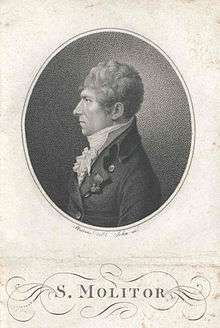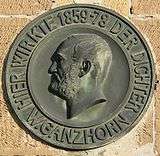Neckarsulm
| Neckarsulm | ||
|---|---|---|
|
| ||
| ||
 Neckarsulm Location of Neckarsulm within Heilbronn district  | ||
| Coordinates: 49°11′30.1″N 9°13′28.4″E / 49.191694°N 9.224556°ECoordinates: 49°11′30.1″N 9°13′28.4″E / 49.191694°N 9.224556°E | ||
| Country | Germany | |
| State | Baden-Württemberg | |
| Admin. region | Stuttgart | |
| District | Heilbronn | |
| Government | ||
| • Mayor | Joachim Scholz (2008) | |
| Area | ||
| • Total | 24.94 km2 (9.63 sq mi) | |
| Elevation | 162 m (531 ft) | |
| Population (2017-12-31)[1] | ||
| • Total | 26,428 | |
| • Density | 1,100/km2 (2,700/sq mi) | |
| Time zone | CET/CEST (UTC+1/+2) | |
| Postal codes | 74172 | |
| Dialling codes | 07132 | |
| Vehicle registration | HN | |
| Website | Neckarsulm.de | |
Neckarsulm (German pronunciation: [nɛkarˈzʊlm]) is a city in northern Baden-Württemberg, Germany, near Stuttgart, and part of the district of Heilbronn. As of 2004, Neckarsulm had 27,296 inhabitants.
The rivers Neckar and Sulm join there, hence the name, which is often misunderstood or mispronounced as "Neckars Ulm", an incongruity that would mean the Ulm of the Neckar, as the city of Ulm is well to the east on the Danube at the border between Baden-Wuerttemberg and Bavaria.
Neckarsulm is famous for being ranked first in the German Solarbundesliga (cities beginning at 10,000 inhabitants), a competition in renewable energy installations. Its other fame is that the Neckarsulm-Gundelsheim Weingaertnergenossenschaft (vintner's co-operative) is reputed to be the oldest in Germany; trollinger and lemberger are the principal varieties of grape that are grown.
Buildings and constructions
- Teutonic Knights castle, featuring the Deutsches Zweirad- und NSU-Museum (the combined Motorcycle and NSU Museum of Germany)
- Neckarsulm TDS Office Tower
- Obereisesheim transmitter
- The medieval city wall is mostly intact along the riverside aspect of the town.
Mayors and (since 1973) Lord Mayors
- 1845–1865: Franz Josef Alexander Heinrich Becker
- 1865–1878: Josef Pecoroni
- 1878–1885: Johann Nepomuk Kirner
- 1885–1911: Bernhard Rettenmeier
- 1911–1913: Heinrich Soller
- 1913–1941: Johannes Häußler
- 1942–1945: Oskar Volk
- 1945–1946: Hermann Greiner
- 1946–1949: Johannes Häußler (1879–1949)
- 1949–1955: Erwin Wörner
- 1955–1967: Hans Hoffmann (1915–2005)
- 1967–1992: Erhard Klotz (born 1938)
- 1992–2008: Volker Blust
- 2008–2016: Joachim Scholz [2]
- since 2016: Steffen Hertwig
Population development
The numbers are estimates, census results (¹) or data from statistical offices.
|
|
|
¹ Census results
² The population increase between 1950 and 1961 comes from the new district Neckarsulm-Amorbach. In this place lived in 1955 around 3.00 people.[3]
Economy
Schwarz Gruppe, owner of Lidl and Kaufland — the largest European grocery chain — has its head office in Neckarsulm.[4] The city was the home of the car manufacturer NSU which was taken over by Volkswagen in 1969 and merged with Auto Union to create Audi. The former NSU factory is now one of Audi's two principal assembly plants in Germany (the other is located in Ingolstadt, Bavaria) – and manufactures the company's larger, high end models such as the Audi A6, A7, and A8, the latter is made in the Audi Aluminium Plant, and Audi's performance subsidiary Audi Sport GmbH (which manufactures the R8) is also located here. The NSU logo on early vehicles stands for the city name Neckarsulm.[5]
Personality
Freemen
- 1894: Franz Joseph Maucher (1826–1910) was 35 years chaplain and parish priest in Neckarsulm.
- 1911: Gottlob Banzhaf (1858–1930) was Kommerzienrat and after the death of his brother Christian Schmidt first director the Neckarsulmer Strickmaschinenfabrik AG from 1884 to 1910.
- 1930: Ernst Josef Bauer (1881 † in Ludwigsburg) was a teacher and successful author of the home game "Peter Heinrich Merkle, the Löwenwirt of Neckarsulm".
- 1933: Christian Mergenthaler (1884–1980), NSDAP politician, Prime Minister from 1933 to 1945 of Württemberg. On 27 July 1933 the Neckarsulm council awarded him honorary citizenship. On 28 August 1945, it was deprived him again[7]
- 1949: Johannes Häußler (1879–1949) was about 30 years with interruption mayor.
- 2004: Kurt Bauer (born 1934) was 36 years city council, deputy mayor, SPD parliamentary leader, chairman of the SPD local association.
- 2008: Volker Blust (born 1944) was from 1976 head of the main and personnel office and was elected in 1992 Mayor of Neckarsulm.
Sons and daughters of the town
- 1766 November 3, Franz Simon Molitor, † 21 February 1848 in Vienna, musician

- 1902, 7 August, August Herold, † 8 January 1973 by Neckarsulm; vine growers
Other people connected to the city
- Wilhelm Ganzhorn (born 1818 in Böblingen, † 1880 in Bad Cannstatt) was in Neckarsulm 1859–1878 senior judge. Ganzhorn was a poet, and was known as the author of the text for the song "In the loveliest meadow" (Im schönsten Wiesengrunde).

- Albert Roder (born 1896 in Nuremberg; † 1970 in Heilbronn) was an engineer, who became known for the construction of motorcycles. He was from 1946 to 1961 chief designer at NSU.
- Klaus Zwickel (born 1939 in Heilbronn), German unions functionary and former Chairman of IG Metall. From 1968 to 1983 he was first secretary of the IG-Metall Headquarter Neckarsulm.
- Verena Stenke (born 1981 in Bad Friedrichshall), German artist.
- Dominik Britsch (born 1987 in Bad Friedrichshall), German boxer
Sister Cities
| City | Country | Year |
|---|---|---|
| Carmaux | ||
| Bordighera | ||
| Grenchen | ||
| Zschopau | ||
| Budakeszi |
Gallery
- Main street "Marktstraße"
- Old House of Neckarsulm
 Church "St. Dionysius"
Church "St. Dionysius" Old Castle of the Teutonic Knights "Deutschordensschloss"
Old Castle of the Teutonic Knights "Deutschordensschloss"- Vineyards on mountain "Scheuerberg"
References
- ↑ "Bevölkerung nach Nationalität und Geschlecht am 31. Dezember 2017". Statistisches Landesamt Baden-Württemberg (in German). 2018.
- ↑ Andreas Bracht: OB Joachim Scholz wird in sein Amt eingesetzt. Presse-Information der Stadt Neckarsulm vom 27. Oktober 2008.
- ↑ Bernd Friedel: 50 Jahre Amorbach. Neckarsulm 2005, pp. 6–16.
- ↑ "Impressum Archived 27 July 2014 at the Wayback Machine.." Lidl. Retrieved on 28 September 2012. "Adresse: Lidl Stiftung & Co. KG Stiftsbergstraße 1 74167 Neckarsulm "
- ↑ "Die NSU-Firmengeschichte". Retrieved 2016-01-01.
- ↑ Wilson, Hugo (1995). "The Directory of Motorcycles". The Encyclopedia of the Motorcycle. London: Dorling Kindersley. p. 245. ISBN 0-7513-0206-6.
Around 1890 Neckarsulm Strickmaschinen – "knitting machine" – Union began making bicycles.
- ↑ Anton Heyler: Neckarsulm im Auf und Ab eines halben Jahrhunderts. (s. Literatur), pp. 58 and 92.
External links
| Wikimedia Commons has media related to Neckarsulm. |
- Neckarsulm (in German)
